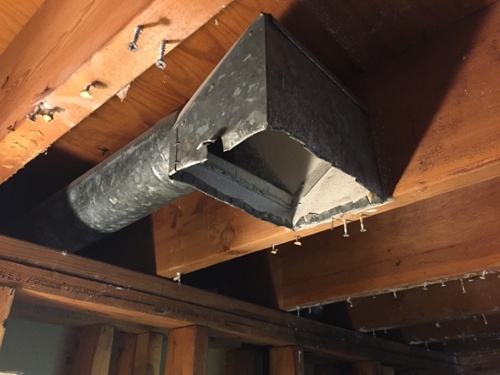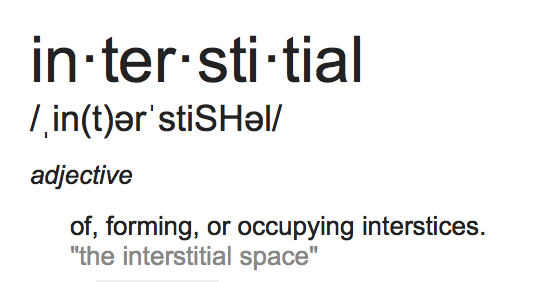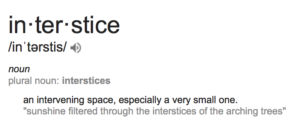Building Science Word of the Day: Interstitial

The word “interstitial” comes up occasionally in building science discussions. I think I’ve heard it a couple of times at conferences just in the past month. That may be because Joe Lstiburek was there. He’s the guy who used that word 127 times in his doctoral dissertation, Toward an Understanding and Prediction of Air Flow in Buildings. Does that give you a clue about its meaning?
If you search Google for the word, here’s the definition they throw at you:

Ah, that’s helpful. Not! Let’s look up the word “interstice” now.

Now we’re getting somewhere. Their example uses sunlight coming through the spaces between leaves. The one I always think about is a net. The open spaces between the strings are the interstices, the interstitial spaces.

I first learned the term in graduate school. Like Joe, I also used the term interstitial in my doctoral dissertation, but in a different context. Here’s a diagram straight from my dissertation.

We were looking at the positions of atoms on silicon surfaces. If you looked at our model of the silicon surface, you’d see something much like the fishing net above: rows of atoms (the knots) held together with bonds (the string between knots). Between the atoms and bonds were empty spaces, the interstices.
What does this have to do with building science?
Go back to the photo at the top of the article. That’s actually the air conditioning duct and boot in my bathroom. That joist bay where it’s located is a building interstice. Air moving in that bay leads to interstitial pressure differences and air movement.
That interstitial space is connected, in our case, to the duct trunkline. That trunk runs to the laundry room, which is connected through interstitial spaces to the fireplace and stairwell. The fireplace and stairwell are connected to the attic.
On the other end of that joist bay in our bathroom ceiling is the band joist. The duct you see above is unsealed. It’s a supply duct. When the heating or air conditioning system is running, that joist bay develops a positive pressure, which drives exfiltration through the unsealed band joist. The good news here is that in my bathroom renovation, I’ve sealed up the band joist and the part of the duct that I can reach.
So when you hear the word “interstitial,” think air leakage. Think duct leakage. Think pressure differences, which drive air movement. John Tooley and Neil Moyer wrote a groundbreaking paper on this topic in the 1980s called MAD AIR – Mechanical Air Distribution And Interacting Relationships. Lstiburek expanded on that work with his dissertation.
Now I’ve finished the article. I’ve reached an interstice in my day.
Allison A. Bailes III, PhD is a speaker, writer, building science consultant, and the founder of Energy Vanguard in Decatur, Georgia. He has a doctorate in physics and writes the Energy Vanguard Blog. He is also writing a book on building science. You can follow him on Twitter at @EnergyVanguard.
Related Articles
Air Flow Pathways in a Leaky Bathroom Wall
I Blew a Gasket — Air Leakage at Electrical Switches and Outlets
The 3 Rules of Air Leakage (Plus a Bonus!)
NOTE: Comments are closed.
This Post Has 15 Comments
Comments are closed.

How’s an “adatom” different
How’s an “adatom” different from an atom?
I just came up with the most
I just came up with the most refreshing idea. Instead having the dryer duct installed on a wall or roof cap and jettisoning the perfectly clean, warm, and spring scented air into the atmosphere lets throw it into the return duct and spread some of that wealth around! Nothing like a summer breeze smell permeating the home on a cold winter day am i right or am i right?
yes im joking.
It’s not. It’s just surface
It’s not. It’s just surface physics nerd lingo for adsorbed atom, to distinguish it from atoms in the main crystal.
I see a market for supply
I see a market for supply registers that let you put dryer sheets in them.
I thought I had seen one
I thought I had seen one brand of replaceable furnace air filter that was impregnated with Febreze.
The idea was patented 4 years
The idea was patented 4 years ago and a variation can be purchased on Amazon.
http://www.google.com/patents/US20120079945
http://www.amazon.com/WEB-FilterFresh-Country-Cotton-Freshener/dp/B002UQFODU/ref=pd_sim_60_4?ie=UTF8&dpID=51hU9ePS9oL&dpSrc=sims&preST=_AC_UL320_SR256%2C320_&refRID=19JX5EBN50BTHERHAW8K
Not to get all philosophical
Not to get all philosophical here, but for a moment, consider the “hole”. Without something to constrain it’s boundaries, can a hole, or space exist?
Holes and interstices are everywhere, but only become defined when they are captured and surrounded by “something”. When we buy a drill bit, we don’t really want the bit, we want the hole it creates. Went to Lowes the other day, told the associate I wanted to buy a 1/2″ hole and was politely escorted out of the building by security. I may have been in the wrong department.
Thanks for keeping us thinking, Allison!
Dale, although someone
Dale, although someone applied for a patent on an Air Freshener Dispensing Register Cover, the patent office denied the application. A number of the form US<7 digits> indicates a patent application publication. A U.S. patent number doesn’t have the year. So, unless someone else has a valid patent on the concept, you are free to make, use, or sell one of these without getting anyone’s permission.
I am simply a homeowner who
I am simply a homeowner who loves energy efficiency. While I have learned more from this blog than any other internet source, it still seems more geared towards the home energy professional. Are there any other resources for someone like me who is looking to make cost-effective improvements in my home? Like a list of items to address in bang-for-your-buck order with detailed instructions. (i.e. air sealing in the attic seems to be the best place to start, but I’m scared that spraying a can of foam around the backside of a light junction box may be against fire code or something – basically I need good directions).
Blake, thanks for reminding
Blake, thanks for reminding me that a lot of people who aren’t in the industry read this blog. I do try to write regularly for homeowners who just want to know the kinds of things you mentioned, and I guess it’s time to do another one. Also, I’m planning to publish some e-books and other collections of articles that you should find helpful. Stay tuned.
In the meantime, you might want to buy a copy of Bruce Harley’s book, Insulate and Weatherize: For Energy Efficiency at Home. http://www.amazon.com/Insulate-Weatherize-Energy-Efficiency-Tauntons/dp/1600854680
I’ve seen too many duct
I’ve seen too many duct leakages that caused bigger issues for home owners. Great article, thanks for sharing!
Thank you!
Thank you!
I’ve been working with LEED
I’ve been working with LEED for Homes projects for years and one of my favorite teachable moments is discussing the durability risk factor for “interstitial condensation”. Once the concept is explained, people tend to get it. But it’s always fun to catch their eyes when first mentioning it – and it definitely becomes a word of the day.
Jason
That reminds me of what one
That reminds me of what one of my professors once said (to paraphrase): “Don’t use words like interstitial when talking to people, they won’t know what you’re saying.”
Here is another blog in the
Here is another blog in the Minneapolis Star Tribune. Another great resource with a little more focus from a homeowner’s perspective. Ruben is a local home inspector with a lot of great insights.
http://www.startribune.com/variety/homegarden/Reuben_Saltzman/